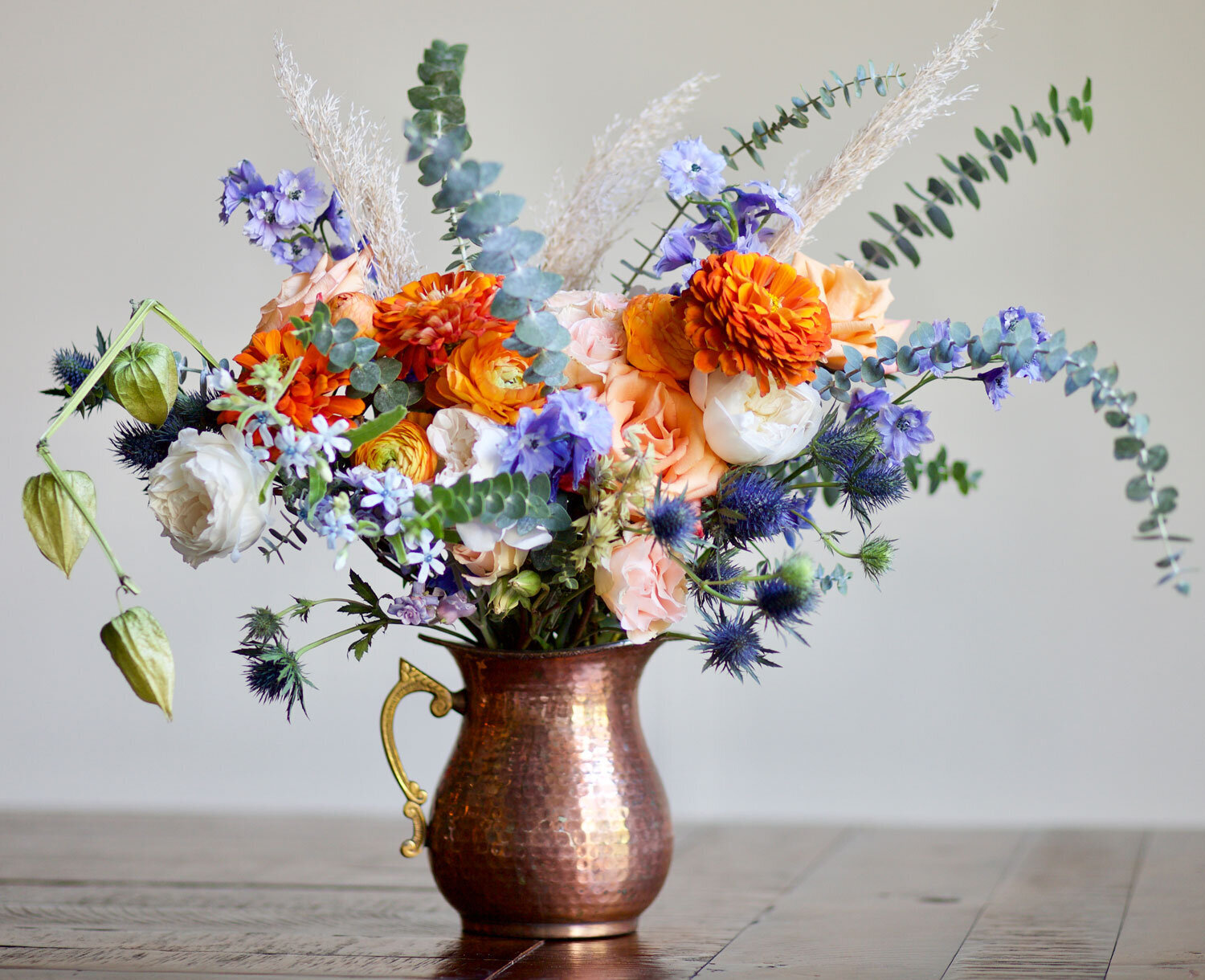You Grow Girl: How to DIY a Flower Arrangement
You grow, girrrl.
Matisse said, “There are always flowers for those who want to see them,” but he never entered a grocery store during COVID times. We admit we haven’t stopped to smell much of anything lately, and our racing thoughts have zipped us right past the floral department. But speaking of blooming where we’re planted, we now invite you to stop and grab some stems.
If you’ve ever done the cut-them-too-long-then-too-short dance, you may find arranging store-bought flowers daunting. To help us achieve that just-delivered look, we turned to Meredith Wallace of Rocking Bird Flower Co. While you’re flowering your nest, you just might discover the joy of arranging. (pictures by Casey Crow Taylor)
The first thing Meredith wants us to know is that what we arrange is more important than how we arrange it. Flower selection can feel overwhelming, particularly if you don't have a lot of faith in your own eye, so Meredith shared a few pointers.
Great Arrangements Start With Great Flowers.
Even if you're a total novice, starting out with good flowers is the difference. Meredith gives Trader Joe's high marks among supermarket chains—great quality, good variety and prices that often beat wholesale consolidators. Whole Foods, too—but as we know, Whole Paycheck is not always worth the extra spend.
Once in store, back away from the pre-arranged flowers. It may seem like the easy out, but Meredith promises that once you get home, you'll find it very difficult to arrange that selection of blooms in any way that doesn’t scream grocery store arrangement! Be brave: Choose your own blooms. The more you do it, the better you'll get.
Save Rainbows For The Pros.
It's easier to make things pretty when you're not juggling a whole range of colors; a rainbow approach needs a sophisticated assortment of what florists call bridging tones, or shades between shades, to feel cohesive. So stick with monochromes. Survey the selection and see what screams out. Perhaps it's a delightful bunch of roses or a lovely carnation—build your color scheme around the most compelling thing you see. If it's a dozen yellow roses, grab those and then select at least three other yellowish bunches of flowers to use in the arrangement. Yes, your arrangement will read "yellow," but that is far better than "hot mess."
Don’t Forget Your Greens.
Now that you found your flowers, add-to-cart some type of greenery. “When you're just starting out, it is the structural element you'll use to create the foundational shape of your arrangement and will give a nice touch of the garden to your work,” Meredith says. Hot tip: Greenery is always considered a neutral in flower design.
Gather Supplies.
If you just want to use some scissors and plunk your flowers into a mason jar, be our guest. If you think that this is something you might like to enjoy more often, you might want to invest in some of Meredith’s “go to” tools, including:
Scissors. Widely beloved in the floral community, this pair from Joyce Chen is a little pricey, but worth the investment. Buy a pair, keep for life (they’re also handy in the kitchen).
A nice compote. If she had to pick one superhero vase, Meredith suggests a small- to mid-size neutral ceramic footed bowl (the smaller of the two). Glass reveals both murky water and all your underwater mechanics.
Flower frog. You'll need a structural device to anchor your flowers at the base of your vessel—and Meredith’s all star pick is the flower frog, a weighted pronged device that resembles a pin cushion. Affixed at the base of your vessel, the frog will skewer your flower stems and hold your arrangement.
Flower putty. To affix the flower frog to the bottom of your compote, you'll need some sticky flower clay or putty. One roll should be plenty—once you've affixed the frog to the base of your compote, you'll very rarely have to re-putty it.
Lazy susan. While more of a nice-to-have, Meredith says putting your compote on a lazy susan allows you to easily spin the arrangement and see it from multiple angles—which can help beginners get their arrangement’s shape right. A visually balanced arrangement is particularly useful if your arrangement is going on a surface that will be viewed from multiple directions, like a dinner table.
Arrange Away.
Now to the arranging. Remove packaging and save the little packets of flower food that come with grocery store flowers. Dump the flower food into whatever vessel you'll use to hydrate the flowers as you arrange them (save a little bit of flower food to put into the water going into your compote). Next, give all of your flower stems a fresh clean cut, about an inch from the end at a diagonal. Don't take too much off, in case you need some stems with height. Remove any greenery, leaves or foliage that fall below the water line in your bucket—these can spoil your arrangement if left underwater.
Ready? Start with greenery. Meredith suggests designing in a series of odd numbers, so start with, say, five to seven pieces of greenery in various lengths and heights. She likes a spilling effect of greenery draped over the sides of the compote. Pro trick: Imagine what a plant might look like if it were growing out of the compote, then mimic those lines and shapes.
Next, add your largest flowers. From a grocery store, these will typically be roses or, if they're open, lilies. Distribute focal flowers throughout the arrangement, at a variety of heights. Try not to clump all the focal flowers on one visual plane. You want them shooting out and snuggling in, giving the arrangement interesting shape and movement. Then, start filling in the gaps created by the space between your focal flowers and greenery (Meredith calls these “windows”) with smaller flowers. If you have a lazy susan, keep spinning your arrangement so you can see all the windows that need filling in.
Finally, Meredith likes to add a plunging piece of greenery that cascades down from the compote—perhaps all the way to the counter if you’re feeling extra saucy—to give the arrangement an overgrown, natural look.
Keep It Blooming.
If your first or second grocery store arrangements aren’t masterpieces, don't hang up your scissors just yet. While flower arranging may seem uncomplicated, like it should always result in Instagram-ready photographs, it isn't and it doesn't. And the process of flowering is deeply calming—so stick with it. If you find yourself hooked, Meredith highly recommends surrounding yourself with inspiration from florists you find mesmerizing. To this day, she still turns to the first flower book she ever purchased, The Flower Workshop by Ariella Chezar, for visual inspiration and aesthetic wisdom.



